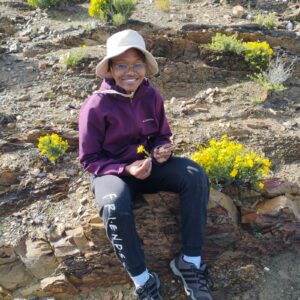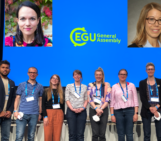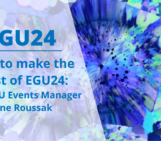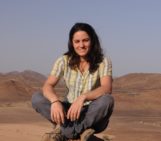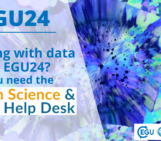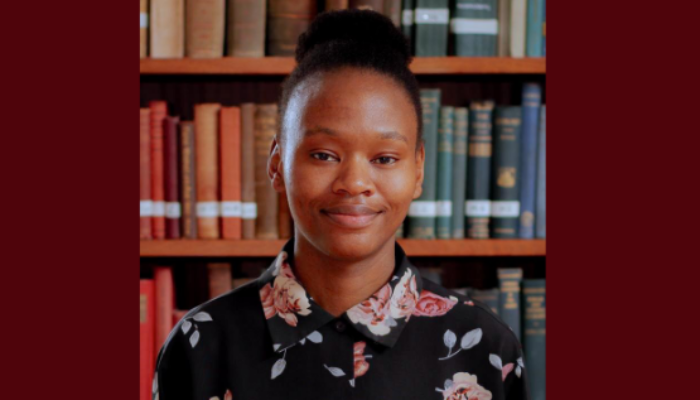
Hello Sinelethu! Thank you for joining this edition of GeoTalk. Could you introduce yourself and your background?
Thank you for inviting me! I am Sinelethu Hashibi, from the Eastern Cape in South Africa. Currently, I am working on my PhD in mantle geochemistry at the University of Cape Town. I am particularly interested in the chemical and thermal structure of the lithospheric mantle, and how that has evolved through time. I use the geochemistry of single kimberlite indicator minerals (e.g., garnets, clinopyroxenes etc.) exhumed by kimberlite pipes to understand the underlying mantle. Lately, I have been working on receiver functions, as a means to compare past chemical and thermal signatures with the present.
Could you tell our readers about the geology communication project you’re involved in: Chosi Ndabazomhlaba?
Chosi Ndabazomhlaba was born from the need to include groups of people that have been previously excluded from the scientific community as a result of colonialism and apartheid. South Africa is a beautiful country, with a number of geological wonders such as the Cape Fold Belts and the Blyde River Canyon. Given that we export a number of economic deposits (gold, diamonds, iron, etc.), the lives of many South Africans are heavily intertwined with the mining sector. Even so, geology still remains unknown. The fact that geology is not offered in schools exacerbates its mystery.
One of the problems our country faces is the language of communication. English still remains the language of instruction in most schools and universities. Studies have proven that people tend to engage and understand better when information is communicated in their mother tongue – this I can attest to. For the longest time, I wished I had someone to explain what I just read from my chemistry textbook or notes, but in isiXhosa.
So, when Dr Rosalie Tostevin pitched the idea of telling geological stories in isiXhosa, I knew it was a project that I had to be a part of. Our main aim has always been to communicate the most interesting and exciting parts of South Africa’s geology in a relaxed and exciting manner. The goal has always been to get everyone curious about the world around them.
One of the project’s key challenges is the lack of equivalent terms for geoscientific phenomena between English and isiXhosa. How do you create a new geoscience vocabulary?
That is indeed true. IsiXhosa is a descriptive language, in a sense that, we usually name things as we perceive them (e.g., the sounds and the actions things make or how they look). For the most part, we have been creating new words that are basically descriptive of what the technical term is. For instance, the Xhosa term for a glacier is “Intaba-mkhenkce”, which directly translates to “a mountain of ice”.
Honestly, this is the hardest part about the project – contextualizing the terms and understanding them enough to coin a new word. The use of storytelling has helped a great deal in this regard. We just come up with the words as we go, which makes the entire project more exciting!
Chosi Ndabazomhlaba avoids technical writing to communicate geoscience through storytelling. Why did you favour a storytelling approach?
Geology lends itself very well to storytelling, since the geological record is a series of chronological events. The approach of storytelling relaxes the tone of the content and invites more people to take part. The goal of this project is to extend an open invitation to invite all South Africans to share in their rich geological history, in the best way we know how: storytelling.
Through the ages, South Africans have told stories about the Earth, the constellations, the moon, and all that we know to be science, in their own way. However, through time, the practice of storytelling has been lost. I guess a part of this project is to reignite that practice. It is a statement that science, like music, knows no language.
Fun fact: when Xhosa people prepare to tell a story, they say, “Chosi chosi ngantsomi” (an equivalent of “once upon a time”), and the listeners would reply, “Chosi ntsomi/ndabazolwimi”, signalling their readiness for the story. Hence the name of our project: Chosi Ndabazomhlaba.
How do you see outreach projects like Chosi Ndabazomhlaba developing in the future?
I see the project developing more in the science education space. There is obviously a long way to go before we have that geological encyclopaedia we envision. But we are determined to present the stories in different ways: oral and written formats. We have recently embarked on doing school drives, where we read the stories to school children. We hope to write a children’s book in isiXhosa.
Recently, we have been working on getting more involved with the Iziko Museum in Cape Town, to translate their scientific shows into isiXhosa and other languages. This project does not only benefit non-specialists: our aim is to equip geologists with a tool that can be used for communicating with the local community when conducting field work. Anyone interested in learning more about the project can also catch up with me at the EGU24 General Assembly, where I will be giving the Katia and Maurice Krafft Award Lecture.

